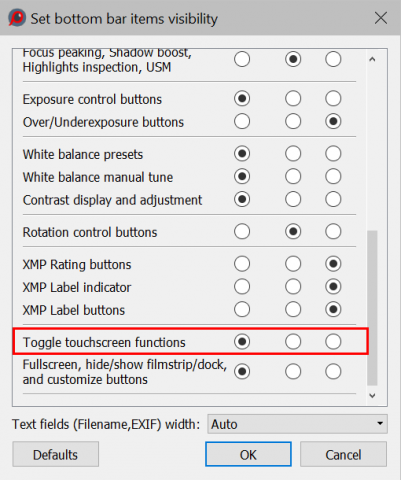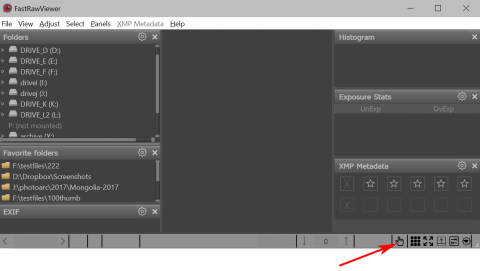Working with Touchscreen
FastRawViewer for Windows 7 – 10 supports the Touchscreen interface. This support is disabled by default; one can enable it via Preferences – Interface - Touchscreen – Enable Touchscreen features.
This support includes the following
- Toolbars for the main action: file navigation, interface mode switching, zoom, setting XMP ratings and labels, RAW data inspection, setting exposure compensation, contrast, and white balance.
- Support for basic gestures on the touchscreen.
When this interface is switched on, the following settings become accessible:
- Enable toolbars, Toolbars size – switches Toolbars on, and allows one to adjust the size of the Toolbars. Toolbars can be switched on for desktops as well, however in this case you may want to change the size down from the default Large. Each Toolbar can be switched on and off via Menu – Panels – Toolbars.
- Highlight toolbar items under mouse – turns on backlighting for the “button under the mouse” (mouse hover): under the default settings (turned on), the button in the toolbar where the mouse is located changes its background color. When navigating with one’s fingertip, this setting may be a bit inconvenient, as moving one’s fingertip outside the screen is not tracked – the last “mouse position” will just be the last button that was pressed. If this is irritating to the user, then this setting ought to be turned off.
- Image Display - Dim image while switching to next
Turns down the brightness of the current image while the program is preparing the display of the new image (decoding it and loading it into the video card). This gives visual feedback if working on a slower tablet to indicate that switching between images is in progress.
Options- Do not dim – works as previous; no brightness decreases while switching between images
- While switching to next file – decreases the brightness by 40% while in the process of switching to another image. This is the default.
- Next file or RAW/JPEG switch – the same as previous, plus a 25% decrease in brightness when switching between RAW and JPEG.
- The White Balance dialog size setting allows one to increase the size of the dialog that manually sets the white balance in Touch screen mode, so as to make it easier to shift with one’s fingers.
Other checkboxes control touch features:
- Single finger filmstrip scroll/grid scroll – the scroll is performed with a single figure gesture.
- Double tap to switch grid/single mode – switches between Grid Mode and displaying a Single File with a double-tap.
- Gesture support in Single File View:
- Single finger pan to switch – allows one to switch images with one finger gesture from left to right). If the zoom is larger than Fit to Screen, instead of switching images the current image is scrolled.
- Pinch to zoom/unzoom – change the zoom level of the image with a pinch.
- Double tap to unzoom (if zoomed): if the image zoom level is larger than Fit to Screen, a double-tap will bring it to Fit to Screen.
If Double tab to switch grid/single mode is turned on, another double tap will return to Grid Mode.
If there is a need to frequently switch to Touchscreen mode and back (for example, when disconnecting-connecting a keyboard), a button for just this function can be activated in the bottom bar.
- To do so, in the settings for the program’s bottom bar (Menu – File – Customize – Customize bottom bar) one needs to turn on Toggle touchscreen functions element (see right).

- After it has been turned on, an icon/button for changing touchscreen mode will appear in the bottom bar (see below):
This button works identically to the way that one changes the touch screen mode through the settings.


